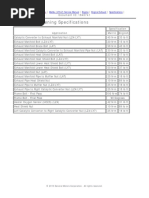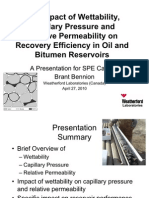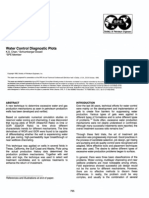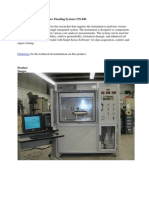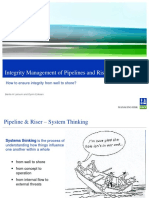Phase Behavior
Uploaded by
chemkumar16Phase Behavior
Uploaded by
chemkumar16Ayala.
qxp
19/1/06
9:30 am
Page 16
Hydrocarbon Fluids
Phase Behaviour of Hydrocarbon Fluids
The Key to Understanding Oil and Gas Engineering Systems
a report by
Luis F Ayala
Assistant Professor of Petroleum and Natural Gas Engineering, The Pennsylvania State University
Luis F Ayala is Assistant Professor of
Petroleum and Natural Gas
Engineering at The Pennsylvania
State University. He has also been
an Instructor in the Chemical
Engineering and Petroleum
Engineering departments at
Universidad de Oriente, Venezuela.
Professor Ayalas research activities
focus on the areas of natural gas
engineering, hydrocarbon phase
behaviour, multiphase flow, numerical
modelling and artificial intelligence.
He is a member of the Society of
Petroleum Engineers (SPE), the
Canadian Petroleum Society and the
National Association of Engineers of
Venezuela. Professor Ayala holds PhD
and MS degrees in petroleum and
natural gas engineering from The
Pennsylvania State University and
two BS degrees, one in chemical
engineering (summa cum laude) and
one in petroleum engineering
(summa cum laude) from Universidad
de Oriente, Venezuela.
Oils and natural gases are naturally occurring
hydrocarbon mixtures found in underground deposits
at high pressure and temperature. The oil and gas
industry focuses on the extraction, production and
processing of those fluids in order to satisfy the energy
demands of todays modern society. This article
examines the need for a true understanding of phase
behaviour of petroleum fluids as the key to mastering
the efficient and profitable extraction, production and
processing of fluids of interest to the industry.
Oil and gas engineering systems handle complex
fluid mixtures whose behaviour is strongly
dependent on chemical make-up. Petroleum fluids
are multi-component mixtures composed of few
non-hydrocarbons and a variety of hydrocarbons
especially of the alkane series. Typical hydrocarbons
encountered in petroleum mixtures are methane and
ethane (the light group), propane and butanes (the
light-intermediate group), pentanes and hexanes
(the heavy-intermediate group) and a heavy group,
or C7+, which usually contributes to the bulk of
heavy petroleum fluids such as crude oil. Nonhydrocarbons are typically nitrogen (N2), carbon
dioxide (CO2) and hydrogen sulphide (H2S), among
few others. Water is another fluid that is typically
found co-existing with naturally occurring
hydrocarbon mixtures.
Not only do oil and gas engineering systems handle
very complex mixtures, but they also operate within
exceptionally wide ranges of pressure and
temperature conditions. Extremely low (cryogenic)
temperatures are required in liquefied natural gas
(LNG) applications, while very high temperatures
(>370C) are needed for thermal cracking of heavy
hydrocarbon molecules. Between these two
extremes, hydrocarbon fluids are found
underground at temperatures that can reach 90C or
more, while surface conditions can hover around
20C. Pressure can vary from its atmospheric value
16
(or lower in the case of vacuum distillation) to a
number in the hundred million pascals (Pa). Within
such an ample range of conditions, hydrocarbon
fluids undergo severe transformations and exist as a
single phase (gas, liquid or solid) or co-exist in
several forms (liquid plus gas, solid plus liquid,
vapour plus solid or even in liquid-plus-liquid
combinations). Understanding how hydrocarbon
fluids interact with and react to their
thermodynamic surroundings is essential to
adequately analyse systems of interest in the oil and
gas industry. For such a task, the petroleum and
natural gas engineer must be equipped with reliable
hydrocarbon phase behaviour prediction tools that
are capable of predicting the thermodynamic state of
the system and associated thermophysical and
volumetric properties.14
Hydrocarbon Reservoir Behaviour
In petroleum and natural gas engineering, attention is
usually focused on regions of co-existence of liquid
and vapour, which are the two phases most
commonly encountered in field applications. One
of the most useful phase behaviour visualisations is
the pressure-temperature (p-T) diagram or p-T
envelope. Each envelope represents a thermodynamic
boundary separating the two-phase conditions (inside
the envelope) from the single-phase region (outside)
(see Figure 1).
p-T diagrams help visualise fluid production paths from
reservoir to surface and assist in the development of
best production schemes and strategies. These diagrams
are important because they can describe fluid
transformations during production (production path),
as they leave the reservoir and reach the surface. Based
on the location of the phase envelope with respect to
initial reservoir pressure and temperature conditions
(pi, Ti), petroleum reservoir fluids are usually classified
into one of the following five categories:
1. Whitson C, Brule M, Phase Behavior, SPE Monograph, volume 20, Henry L Doherty Series, Richardson, Texas (2000).
2. Danesh A, PVT and Phase Behaviour of Petroleum Reservoir Fluids, Developments in Petroleum Science (1998);47,
Elsevier Science B.V.
3. McCain W, The Properties of Petroleum Fluids, 2nd edition, PennWell Books, Tulsa, Oklahoma (1990).
4. Firoozabadi A, Thermodynamics of Hydrocarbon Reservoirs, McGraw-Hill Co. (1999).
BUSINESS BRIEFING: OIL & GAS PROCESSING REVIEW 2006
Ayala.qxp
19/1/06
12:01 pm
Page 17
Phase Behaviour of Hydrocarbon Fluids
black oils;
volatile oils;
retrograde gases (gas condensates);
wet gases, and;
dry gases.
The basic difference between the three different
natural gas fluid types in Figure 1 is their composition
and the relative content of methane and heavy
components (C7+). The location of the critical point
and fluid phase envelope is a function of fluid
composition and, in general, phase envelopes tend to
shift to the right when the relative proportion of heavy
components (C7+) increases. Starting with the
hydrocarbon fluid with the largest relative amount of
methane (the dry gas, fluid A), an increased amount of
C7+ would shift the envelope towards the right and
the fluid would become a wet gas (fluid B). The
natural gas fluid with the highest relative proportion of
heavies in its composition is the gas condensate (fluid
C). These three natural gas reservoirs behave
differently upon fluid withdrawal as shown by the
reservoir depletion path (RDP) and surface depletion
path (SDP) in Figure 1. The reservoir temperature does
not change significantly as fluids are withdrawn, and
therefore pressure depletion at reservoir condition
(RDP) is represented by a vertical line starting from
the conditions of discovery (pi, Ti). As the fluid
reaches the surface, it is subjected to further reduction
of pressure and changes in temperature (SDP). It is
clear from Figure 1 that dry gases do not yield any
liquids, at neither reservoir nor surface condition; wet
gases, on the other hand, produce hydrocarbon liquids
at surface conditions (but not at reservoir conditions).
Upon depletion, gas condensates can generate liquid
hydrocarbon phases both at surface and reservoir
conditions. Gas condensation at reservoir conditions
is, nevertheless, undesirable because it leaves valuable
liquids trapped underground and the liquid impairs the
flow of natural gas out of the reservoir. In the case of
oil reservoirs (volatile and black oils), phase envelopes
are encountered further to the right and downwards in
the p-T plane with respect to the phase envelope of
the gas condensate (fluid C) because of the large
concentration of heavy components (C7+), which
typically prevails in oil mixtures.
The correct identification of the type of hydrocarbon
fluid is critical for the proper design and development
of the correct production strategy for the field under
consideration. This identification is critical for proper
hydrocarbon reservoir modelling as well. According to
the complexity of the reservoir fluid phase behaviour,
reservoir modelling is usually divided into two distinct
groups: black oil simulation and compositional
simulation. When a fluid is assumed to behave as a
black oil, it is assumed that its behaviour is only a
function of pressure and can be regarded as almost
independent of composition. In such a case, reservoir
Figure 1: Phase Envelopes for Natural Gas Reservoir Fluids
Pressure
(pi, Ti)
Fluid A
Fluid B
RDP
SDP
Fluid C
Temperature
Here, three different envelopes for the three natural gas reservoir fluid types dry gas (fluid A), wet gas (fluid B) and gas
condensate (fluid C) are shown. Each envelope is made of two curves: the dew-point curve (right arm, where the transition
from two-phase to single-phase gas occurs and vice versa) and the bubble-point curve (left arm, where the transition from
single-phase liquid to two-phase occurs and vice versa). Both arms meet at the critical point, which is shown with dark dots.
For a given composition, the prevailing pressure and temperature conditions will determine if the fluid state is all liquid
(single-phase), all gas (single-phase) or gasliquid (two-phase). A reservoir fluid originally found as a single-phase (pi, Ti
outside the phase envelope) can develop a second phase upon pressure depletion by crossing the fluids phase envelope,
as depicted by the isothermal reservoir depletion path (RDP) for the case of fluid C in this figure.
pi, Ti = initial pressure and temperature conditions, SDP = surface depletion non-isothermal path.
hydrocarbon fluids are assumed to comprise two
components stock tank oil and surface gas. The
black oil model allows for a certain amount of surface
gas to be in solution with the stock tank oil at reservoir
conditions. The amount of dissolved gas increases
with, and is a sole function of, pressure for conditions
below the bubble point. Above the bubble point
pressure, the oil component carries all the available gas
in the reservoir, and a variable bubble point
algorithm is usually implemented to predict conditions
for the release of the dissolved gas. For this simplified
black oil model to be valid, actual oil and gas phases
should maintain a fixed composition throughout the
process simulated in the reservoir. In certain cases, the
assumption of fixed oil and gas composition is no
longer valid. More complex fluid behaviour requires
all hydrocarbon phases to be treated as nc component
mixtures and, thus, a compositional simulation to be
performed. In selecting the appropriate model for a
given fluid reservoir, computational overhead
becomes a limiting factor.
Production, Treatment and Processing
Reservoir fluids are brought to the surface as a mixture
of oil, gas and water, which is sent to a surface
production facility before they can be disposed or sold
to an industrial costumer (e.g. a refinery). A surface
production facility is the system in charge of the
separation of the wellstream fluids into its three singlephase components oil, gas and water and of their
transport and processing into marketable products
and/or their disposal in an environmentally acceptable
manner. Once separated, crude oil, natural gas and
water follow different paths. Water is typically
re-injected for reservoir pressure maintenance
operations. Crude oil usually goes through a process of
dehydration, which removes basic sediments and
BUSINESS BRIEFING: OIL & GAS PROCESSING REVIEW 2006
17
Ayala.qxp
19/1/06
9:32 am
Page 18
Hydrocarbon Fluids
Figure 2: Pipeline Operational Curve and Phase Envelope of Transported
Natural Gas
Operational region
Pressure
Critical point
Operational curve
Gas A
Gas B
Gas C
Gas D
Temperature
In this figure, it should be noted that the right arm (dew-point curve) is largely susceptible to the presence of heavies in the
natural gas composition. Depending on the gas composition, it is seen how the pipeline operational region can be either
completely free of liquid (gas A, the driest) or partially submerged in the two-phase region (gases B and C). If the gas is wet
enough, the pipeline will be entirely subjected to two-phase conditions (gas D, the wettest). The sensitivity of the right arm to
heavies may be described as having a hook-seizing effect; the larger the extent of heavies in the natural gas, the more the
hook is able to seize part of the pipeline operational region.
water (BS&W), desalting or reduction of salt
concentration and sweetening or removal of H2S and
other sulphur compounds and stabilisation. Natural gas
usually goes through a process of conditioning, which
includes the removal of liquids, removal of acid gases
such as CO2 and/or H2S (sweetening) and drying or
removal of water vapour (dehydration). Surface
production operations thus consist of two main
sections: the separation of oil, water and gas coming
from the wellbore into three phases; and the removal
of the unwanted sediments and impurities from the
three different phases before the stages of custody
transfer, storage and/or re-injection.
Production fluids undergo important property
changes as they flow through the production system.
How to best manipulate pressure and temperature
changes in order to get an optimum product is the
main goal of the engineer in charge of the design of
surface production facilities. Phase behaviour is thus
the quintessential tool required for such design.
Transportation and Distribution
18
Once hydrocarbon fluids are produced and processed,
the final consumers may be few to several hundred
miles away. A cost-effective means of transport is
essential to bridge the gap between the producer and
consumer. Pipeline transportation has become the
most popular means of transporting fluids from the
wellhead to processing and from there to the final
consumer since it better guarantees continuous
delivery and assures low maintenance costs.
However, not all crude oil and natural gas is
transported by pipeline. Crude oil is typically
transported with tankers through the oceans, when
distances become prohibitively large for pipeline
usage. Transportation of natural gas across the oceans
requires its transformation to a condensed form that
can minimise volume storage requirements. LNG is
the liquefied version of dry natural gases at ultralow
temperatures (approximately -162C at atmospheric
pressure). LNG trade requires the construction of a
liquefaction facility close to the production site and a
regasification facility in the importing country. Phase
behaviour will naturally control LNG operations.
Figure 2 shows four typical phase envelopes for surface
natural gases transported through pipeline systems.
The four natural gases differ in the amount of heavy
components remaining in the the gas composition
(wetness). The shaded area shows, schematically, the
description of the pipeline operational region. As the
location of the pipeline operational region is more or
less given by contractual and design considerations,
liquid presence in a gas pipeline is ultimately dictated
by the properties of the gas that is being transported
and the location of its phase envelope. A pipeline
handling a dry gas (gas A in Figure 2) will be operating
a single-phase mode from its inlet to its outlet. For
this case, any of the popular single-phase gas
equations (Weymouth, Panhandle type or AGA
equation) could be used for design purposes and to
help predicting actual operational curve (p-T trace). If
a richer gas comes into the system (gas C in Figure 2),
it will have a single-phase condition at the inlet, but
after a certain distance, the pressure and temperature
conditions will be within the two-phase region and
cause an exacerbated pressure loss. The system may
also be transporting a wetter gas (gas D in Figure 2), in
which case it would encounter two-phase conditions
both at the inlet and the outlet of the pipe. Twophase pipe flow of rich natural gases is modelled by
invoking the basic principles of continuum mechanics
and fluid phase behaviour.
Conclusions
From subsurface to final destination, hydrocarbon
fluids undergo many property-altering intermediate
stages. Understanding of fluid phase behaviour i.e.
the behaviour of all possible phases as a function of
composition, pressure and temperature is essential
for optimal design and safe and efficient operation of
oil and gas engineering systems. A reliable phase
behaviour prediction tool is the backbone of
hydrocarbon reservoir modelling, reserve estimation,
wellbore hydraulics, gas metering and quality control,
design of surface separation facilities and
transportation and distribution systems, compressor
design, enhanced oil and gas recovery operations,
among several others. A phase behaviour predictor is
typically built on the basis of a cubic equation of state
and it constitutes the workhorse of oil and gas
engineering design and, thus, the key to
understanding oil and gas engineering systems.
BUSINESS BRIEFING: OIL & GAS PROCESSING REVIEW 2006
You might also like
- 2008 Chevrolet Malibu Service Repair Manual PDF100% (1)2008 Chevrolet Malibu Service Repair Manual PDF19 pages
- (Ebook) - (Drugs) - (Methamphetamine) - (Nazi Labs) - (How To Make Crystal Meth)100% (4)(Ebook) - (Drugs) - (Methamphetamine) - (Nazi Labs) - (How To Make Crystal Meth)7 pages
- WettabilityCapillaryPressureinHeavyOil 20100427No ratings yetWettabilityCapillaryPressureinHeavyOil 2010042760 pages
- How Lorenz Plots Are Made in Petrel RevisedNo ratings yetHow Lorenz Plots Are Made in Petrel Revised13 pages
- 2.15 Capillary Pressure and Saturation-Height v3No ratings yet2.15 Capillary Pressure and Saturation-Height v32 pages
- Craft and Hawkins - Applied Petroleum Reservoir Engineering - Bab 5100% (3)Craft and Hawkins - Applied Petroleum Reservoir Engineering - Bab 519 pages
- 01-Introduction To Reservoir SimulationNo ratings yet01-Introduction To Reservoir Simulation18 pages
- C o U R S e N o - PENG 331 Reservoir EngineeringNo ratings yetC o U R S e N o - PENG 331 Reservoir Engineering3 pages
- TM4112 - 2 Introduction To Reservoir Simulation100% (1)TM4112 - 2 Introduction To Reservoir Simulation19 pages
- Optimizing Water Inj Rate For Waterflooding Field50% (2)Optimizing Water Inj Rate For Waterflooding Field1 page
- Nitrogen Injection in The Cantarell Complex SPE-97385100% (1)Nitrogen Injection in The Cantarell Complex SPE-973856 pages
- Headlines:: Alpha Wildcat Finds Thick Oil Zone!No ratings yetHeadlines:: Alpha Wildcat Finds Thick Oil Zone!18 pages
- The Role of Reservoir Simulation in Optimal Reservoir ManagementNo ratings yetThe Role of Reservoir Simulation in Optimal Reservoir Management10 pages
- Presentación Louis Mattar Testing - SPENo ratings yetPresentación Louis Mattar Testing - SPE44 pages
- Advancing Reservoir Geomechanics Research For Unconventional ResourcesNo ratings yetAdvancing Reservoir Geomechanics Research For Unconventional Resources1 page
- PET 504 Advanced Well Test Analysis: Spring 2015, ITUNo ratings yetPET 504 Advanced Well Test Analysis: Spring 2015, ITU72 pages
- Day 1 PM - Technical Evidence & Ormen LangeNo ratings yetDay 1 PM - Technical Evidence & Ormen Lange52 pages
- Ch. 7 - Naturally Fractured Reservoirs, Carbonates: Advanced Well Test AnalysisNo ratings yetCh. 7 - Naturally Fractured Reservoirs, Carbonates: Advanced Well Test Analysis150 pages
- SPE-160127-MS Kuparuk River Unit Field - The First 30 YearsNo ratings yetSPE-160127-MS Kuparuk River Unit Field - The First 30 Years13 pages
- Petroleum Geology Reading - Calgary 2024No ratings yetPetroleum Geology Reading - Calgary 202445 pages
- Advanced Petroleum Reservoir Simulation: Towards Developing Reservoir EmulatorsFrom EverandAdvanced Petroleum Reservoir Simulation: Towards Developing Reservoir EmulatorsNo ratings yet
- Formation Testing: Supercharge, Pressure Testing, and Contamination ModelsFrom EverandFormation Testing: Supercharge, Pressure Testing, and Contamination ModelsNo ratings yet
- A Guide Book: Sub-Surface Data Management for Data Managers (Oil & Gas Sector) Volume -1 SeismicFrom EverandA Guide Book: Sub-Surface Data Management for Data Managers (Oil & Gas Sector) Volume -1 SeismicNo ratings yet
- Exploiting the Digital Oilfield: 15 Requirements for Business ValueFrom EverandExploiting the Digital Oilfield: 15 Requirements for Business Value5/5 (1)
- Products: About Us Services Press-Centre Projects Supporting MaterialsNo ratings yetProducts: About Us Services Press-Centre Projects Supporting Materials1 page
- Does Salinity Affect Seawater's PH?: 2 AnswersNo ratings yetDoes Salinity Affect Seawater's PH?: 2 Answers2 pages
- Imtp High-Performance Random Packing: Norton Chemical Process Products Corporation100% (1)Imtp High-Performance Random Packing: Norton Chemical Process Products Corporation16 pages
- DiagnosticsProcedureOnPowerStroke6.0L 11.2010100% (1)DiagnosticsProcedureOnPowerStroke6.0L 11.20107 pages
- 2005DuramaxManual Like s10 Diesel Engines PDFNo ratings yet2005DuramaxManual Like s10 Diesel Engines PDF78 pages
- "6.0L Power Stroke Diagnostics": Technical Article67% (3)"6.0L Power Stroke Diagnostics": Technical Article4 pages
- 2000 Super Duty F-250, F-350, F-450, F-550 Owner Guide100% (7)2000 Super Duty F-250, F-350, F-450, F-550 Owner Guide256 pages
- FoundOcean Fabric Formwork Grout Bag CatalogueNo ratings yetFoundOcean Fabric Formwork Grout Bag Catalogue20 pages
- 5 DNV - Integrity Management of Pipelines and Risers PDFNo ratings yet5 DNV - Integrity Management of Pipelines and Risers PDF16 pages
- YZ Product Introduction - Odorant PackageNo ratings yetYZ Product Introduction - Odorant Package16 pages
- Principle of Metal Magnetic Memory MethodNo ratings yetPrinciple of Metal Magnetic Memory Method6 pages
- Welmec: Guide For Common Application of MID MI-005 and OIML R117-1, (R81, R80, R139)No ratings yetWelmec: Guide For Common Application of MID MI-005 and OIML R117-1, (R81, R80, R139)17 pages



